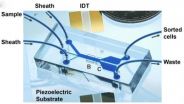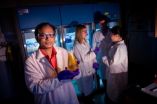Tilted acoustic tweezers separate cells gently
2014-08-25
(Press-News.org) Precise, gentle and efficient cell separation from a device the size of a cell phone may be possible thanks to tilt-angle standing surface acoustic waves, according to a team of engineers.
"For biological testing we often need to do cell separation before analysis," said Tony Jun Huang, professor of engineering science and mechanics. "But if the separation process affects the integrity of the cells, damages them in any way, the diagnosis often won't work well."
Tilted-angle standing surface acoustic waves can separate cells using very small amounts of energy. Unlike conventional separation methods that centrifuge for 10 minutes at 3000 revolutions per minute, the surface acoustic waves can separate cells in a much gentler way. The power intensity and frequency used in this study are similar to that used in ultrasonic imaging, which has proven to be extremely safe, even for fetuses. Also, each cell experiences the acoustic wave for only a fraction of a second, rather than 10 minutes.
"The tilted-angle standing surface acoustic waves method has the least disturbance or disruption to the living cells being separated compared to other available methods so far," said Ming Dao, principal research scientist, materials science and engineering, Massachusetts Institute of Technology. "It adds to the portfolio of latest technology developments for separating such things as rare circulating tumor cells in the blood."
Previous work by Huang showed that acoustic tweezers work by setting up a standing surface acoustic wave. If two sound sources are placed opposite each other and each emits the same wavelength of sound, there will be a location where the opposing sounds cancel each other. Because sound waves have pressure, they can push very small objects, so a cell or nanoparticle will move with the sound wave until it reaches the location where there is no longer movement.
If the sound sources are at right angles to each other, an evenly spaced set of rows and columns form in a checkerboard pattern. In this case, the team from Penn State, MIT and Carnegie Mellon University used simulation programs to determine the angle the sound sources should be tilted at to produce the best separation. They report their results today (Aug. 25) online in the Proceedings of the National Academies of Science.
By tilting the sound source so that it is not perpendicular, the researchers created better separation distance and could more efficiently sort cells.
The acoustic tweezers are made by manufacturing an interdigital transducer, which creates the sound, onto the piezoelectric chip surface. Standard photolithography creates microchannels in which the liquid containing the cells flow.
The researchers created the separator, which can run continuously. The device separated 9.9-micrometer particles from 7.3-micrometer particles so efficiently that 97 percent of the 7.3-micrometer particles went to the correct location. The device can also separate cancer cells from white blood cells with high efficiency and purity. It is simple and inexpensive to fabricate and does not need strict alignment to achieve this separation.
"The method we describe in this paper is a step forward in the detection and isolation of circulating tumor cells in the body," said Subra Suresh, one of the study's authors and president of Carnegie Mellon University. "It has the potential to offer a safe and effective new tool for cancer researchers, clinicians and patients."
The researchers see devices like this one separating cancer cells from other cells, bacteria from blood, white blood cells from red blood cells and malaria parasites from blood, to name a few uses.
INFORMATION:
Other Penn State researchers on this project were Xiaoyun Ding, graduate student and co-lead author; Sz-Chin Steven Lin, graduate student; Peng li, post doctoral fellow and Yuchao Chen, graduate student, engineering science and mechanics; and Sixing Li, graduate student, cell and developmental biology.
Other researchers were Zhangli Peng, former postdoctoral fellow, materials science and engineering, and Michela Geri, graduate student, mechanical engineering, both at MIT.
The National Institutes of Health and the National Science Foundation funded this work.
ELSE PRESS RELEASES FROM THIS DATE:
New biomarker highly promising for predicting breast cancer outcomes
2014-08-25
A protein named p66ShcA shows promise as a biomarker to identify breast cancers with poor prognoses, according to research published ahead of print in the journal Molecular and Cellular Biology.
Cancer is deadly in large part due to its ability to metastasize, to travel from one organ or tissue type to another and malignantly sprout anew. The vast majority of cancer deaths are associated with metastasis.
In breast cancer, a process called "epithelial to mesenchymal transition" aids metastasis. Epithelial cells line surfaces which come into contact with the environment, ...
Exposure to toxins makes great granddaughters more susceptible to stress
2014-08-25
Scientists have known that toxic effects of substances known as endocrine disrupting chemicals (EDCs), found in both natural and human-made materials, can pass from one generation to the next, but new research shows that females with ancestral exposure to EDC may show especially adverse reactions to stress.
According to a new study by researchers from The University of Texas at Austin and Washington State University, male and female rats are affected differently by ancestral exposure to a common fungicide, vinclozolin. Female rats whose great grandparents were exposed ...
MU researchers discover protein's ability to inhibit HIV release
2014-08-25
COLUMBIA, Mo. — A family of proteins that promotes virus entry into cells also has the ability to block the release of HIV and other viruses, University of Missouri researchers have found.
"This is a surprising finding that provides new insights into our understanding of not only HIV infection, but also that of Ebola and other viruses," said Shan-Lu Liu, M.D., Ph.D., associate professor in the MU School of Medicine's Department of Molecular Microbiology and Immunology.
The study was recently published in the Proceedings of the National Academy of Sciences. Liu, the ...
Cancer-fighting drugs might also stop malaria early
2014-08-25
DURHAM, N.C. -- Scientists searching for new drugs to fight malaria have identified a number of compounds -- some of which are currently in clinical trials to treat cancer -- that could add to the anti-malarial arsenal.
Duke University assistant professor Emily Derbyshire and colleagues identified more than 30 enzyme-blocking molecules, called protein kinase inhibitors, that curb malaria before symptoms start.
By focusing on treatments that act early, before a person is infected and feels sick, the researchers hope to give malaria –- especially drug-resistant strains ...
Sweet! Glycoconjugates are more than the sum of their sugars
2014-08-25
There's a certain type of biomolecule built like a nano-Christmas tree. Called a glycoconjugate, it's many branches are bedecked with sugary ornaments.
It's those ornaments that get all the glory. That's because, according to conventional wisdom, the glycoconjugate's lowly "tree" basically holds the sugars in place as they do the important work of reacting with other molecules.
Now a chemist at Michigan Technological University has discovered that the tree itself—called the scaffold—is a good deal more than a simple prop.
"We had always thought that all the biological ...
Doctors miss opportunities to offer flu shots
2014-08-25
Doctors should make a point of offering a flu vaccine to their patients. A simple reminder could considerably reduce the number of racial and ethnic minorities who currently do not vaccinate themselves against this common contagious respiratory illness. This recommendation is based on research led by Jürgen Maurer of the University of Lausanne in Switzerland and the RAND Corporation in the US. Their findings¹ are published in the Journal of General Internal Medicine², published by Springer.
Up to 50,000 Americans die annually of influenza and related diseases such as ...
New coping strategy for the memory impaired and their caregivers
2014-08-25
CHICAGO --- Mindfulness training for individuals with early-stage dementia and their caregivers together in the same class was beneficial for both groups, easing depression and improving sleep and quality of life, reports new Northwestern Medicine study.
"The disease is challenging for the affected person, family members and caregivers," said study lead author Ken Paller, professor of psychology at Weinberg College of Arts and Sciences at Northwestern and a fellow of the Cognitive Neurology and Alzheimer's Disease Center at Northwestern University Feinberg School of ...
To deter cyberattacks, build a public-private partnership
2014-08-25
CHAMPAIGN, Ill. — Cyberattacks loom as an increasingly dire threat to privacy, national security and the global economy, and the best way to blunt their impact may be a public-private partnership between government and business, researchers say. But the time to act is now, rather than in the wake of a crisis, says a University of Illinois expert in law and technology.
According to a study by Jay Kesan, the H. Ross and Helen Workman Research Scholar at the College of Law, an information-sharing framework is necessary to combat cybersecurity threats.
"Cybersecurity is ...
Learning by watching, toddlers show intuitive understanding of probability
2014-08-25
Most people know children learn many skills simply by watching people around them. Without explicit instructions youngsters know to do things like press a button to operate the television and twist a knob to open a door. Now researchers have taken this further, finding that children as young as age 2 intuitively use mathematical concepts such as probability to help make sense of the world around them.
In a study led by researchers at the University of Washington, toddlers could tell the difference between two different ways an experimenter played a game, with one strategy ...
Fires above the Great Slave Lake in Canada
2014-08-25
Updates from NWTfire.com report that there are 133 active fires in the North Slave Region of the Northwest Territories. No new fires reported in the past 24 hours. Fire danger is moderate to high. Smoke may be an issue in some communities.
The Birch Lake Complex of fires are in an area approximately 80 km south of Behchoko and extending to within 30 km north of Fort Providence. Four crews will be working on hot spots and mopping up at Moraine Point this week. Mop-up continues many areas of complex's fire perimeter. The total fire complex area is estimated at 650,000 ...








